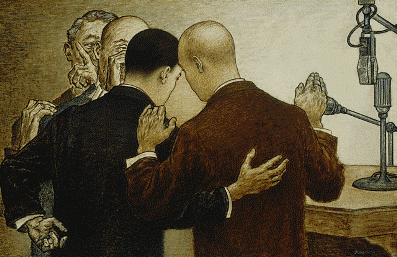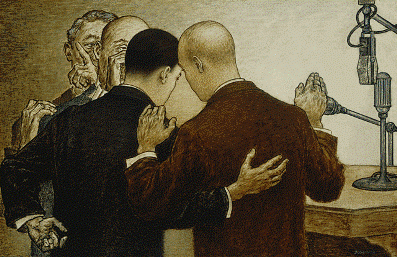I was a double major as an undergraduate, in art history and political science, and have always loved the intersection of art and politics. I think that was what first drew me to Edward Biberman, particularly his 1955 painting Conspiracy, currently on view in the Ahmanson Building as part of a focused installation of LACMA’s Biberman holdings.

Edward Biberman, Conspiracy, c. 1955, LACMA, purchased with funds provided by the Judith Rothschild Foundation; Hansen, Jacobson, Teller, Hoberman, Newman, Warren & Sloane, L.L.P.; Daniel Greenberg and Susan Steinhauser; the Frederick R. Weisman Philanthropic Foundation; Dr. Judd Marmor; Paul and Suzanne Muchnic; the Reese E. and Linda M. Polesky Family Foundation; and Marvin and Judy Zeidler
The image is a very striking one, infused with a creepy quality. No one’s face is fully visible—indeed two of the four men are only seen from the rear—and the strangely paired hands seem almost cadaverous. The thinly painted surface and odd, slightly acidic palette add to the tension of the scene depicted. What exactly is the subject here? The painting’s title offers a hint; Biberman’s biography supplies the rest. One of the best California painters working in a modernist idiom, Biberman was born in Philadelphia in 1904. Rather than joining the family garment business, he chose to study art, first in his hometown and then in Paris. After settling temporarily in New York, he followed his screenwriter brother Herbert to Los Angeles in 1936 and established himself as a portraitist. Edward increasingly incorporated social concerns into his paintings, his political consciousness heightened by the Spanish Civil War and the international rise of fascism. Then, in 1947, disaster struck the Biberman family. Edward’s brother Herbert was called before the House Un-American Activities Committee in Washington, D.C. to testify about his allegedly politically subversive acts. Citing his first-amendment rights to free speech and assembly, Herbert refused to testify (he and nine other filmmakers who similarly refused were dubbed the Hollywood Ten), and as a result later spent five months in prison and was blacklisted from the film industry. His brother’s experience had a profound impact on Edward. He stopped painting for a while, explaining later that “during the specific period…that my brother was imprisoned and denied the opportunity to do his work, I, in good conscience, could not just go normally into my studio and carry on my profession.” Edward himself came under official criticism for his leftist leanings during these years, and he resigned from his teaching position at Art Center to avoid being dismissed. After he returned to painting in the early 1950s, Biberman created Conspiracy, clearly a reference to his brother’s harrowing and anxiety-inducing experience before the HUAC. The power of the image is heightened, however, by its very lack of specificity. While its roots lie in one individual’s personal history, its “moral,” if you will, is much broader. In fact, it could just as easily refer to current events such as the Chinese government’s 81-day detention of artist Ai Weiwei this past spring. Eternal vigilance truly is the price of liberty, and art can play an important role. Carol S. Eliel, Curator of Modern Art



